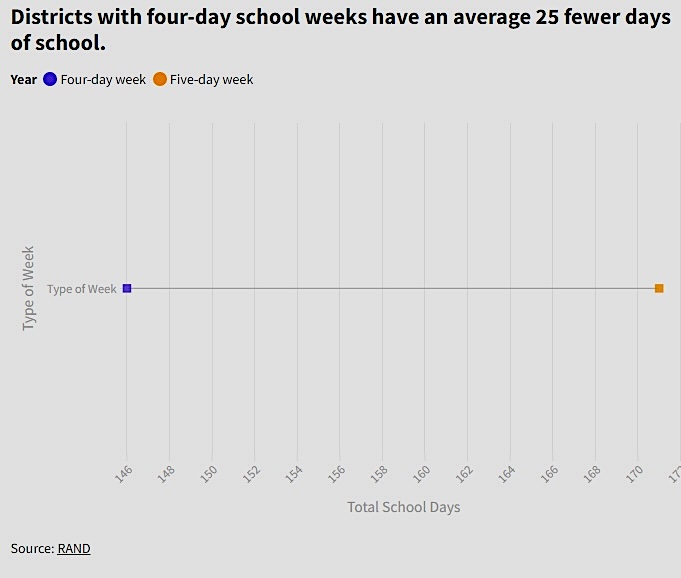Nationwide, about 90 percent of four-day school weeks are used by rural, White populations. Here’s what Black families should know about the model.
By Maya Pottiger
Word in Black
Coming out of the COVID-19 pandemic, teachers, educators and parents have been playing catch up.
The recent National Assessment of Educational Progress (NAEP) report showed devastating declines in math and reading achievement levels. On top of that, schools nationwide continue to struggle with chronic absenteeism and staffing shortages.
So Paul Thompson, an associate professor of economics at Oregon State University, finds it odd that schools have started shifting to a four-day model as an effort to recruit and retain key personnel. It also goes against the other lesson we learned from the pandemic: numerous families rely on schools for valuable resources.
Sign up for our Daily eBlast to get coverage on Black communities from the media company who has been doing it right for over 130 years.
“There’s these big equity concerns about shifting the burden of what schools have traditionally done for students and parents and communities — providing child care, food provision, physical activity, all of those things — and are shifting away from the school district onto families and communities on that additional day,” Thompson says. “What the implications of that are is extremely important, as well.”
Currently, it’s a small sample of schools concentrated in a handful of states — or about 7 percent of districts, mostly in Oregon, Missouri, Colorado, Texas, and New Mexico – that are utilizing the four-day school week.
As researchers study the impacts of these shortened school weeks, they’re asking key questions: Who is mostly being impacted by this? And what are the impacts?
Mostly White, Rural Students — For Now
Four-day school weeks currently exist in mostly rural, White communities. But as the concept gains popularity, states with large indigenous student bodies are also adopting the practice.
Across the country, 90 percent of districts using a four-day model are rural, and they have an average of 454 total students enrolled in the district, according to an MIT study. Looking at districts with the five-day model, only half are rural, and the average enrollment is 3,735 students.
“But, as this continues to grow, and as teacher shortages affect schools from across the spectrum of different types of districts, we may see this model continue to expand into urban areas,” Thompson says.
Colorado’s 27J School District, with nearly 23,000 students, is now the largest district using a four-day model — and preliminary results aren’t good, with a study reporting home prices and student achievement both declined. And Independence School District in Missouri, which also adopted it, serves more than 14,000 students.
However, RAND study participants cautioned that while the four-day model worked in their rural communities, it wouldn’t be as accepted in places like “big cities,” where key factors would be different, like higher numbers of working parents and higher childcare costs.
And these homogenous districts have made it difficult to study the impacts on a range of racially or socioeconomically diverse students. Instead, the research has mostly focused on the average impact.
The MIT study offers a window into this, finding districts with the four-day model have “significantly smaller portions” of Black and Asian students and a significantly higher portion of free or reduced-price lunch-eligible student population than five-day districts.
“We’re still a little off from really understanding what the true equity concerns are here,” Thompson says. “That’s a big thing that’s currently missing. We know how it affects the average student, but what about these more at-risk students, either academically or financially?”
As more districts around the country consider switching, William Rodick, Ph.D., the P-12 practice lead at the Education Trust, says he hopes they’re thinking about lessons learned in the pandemic.
NAEP results continue to show concern in general student progress in math and reading, but especially for Black and Latino students, English learners, and students from low-income backgrounds. These students, in particular, rely on schools to provide food, devices, and high-speed internet.
If they need those supports on those other four days, Rodick says, they’re also going to need them on the fifth.
“These are students who rely on school supports and additional educational services, students that really need to build strong relationships with teachers,” Rodick says. “So taking an additional day of contact, we can imagine that’s going to have negative consequences on certain student groups.”
Not Promising for Student Achievement
Generally, research — and experience — shows that when students spend less time in front of teachers, it has a negative impact on achievement.
When Oregon schools made the switch, students lost three to four hours of classroom time, and that “translated almost directly to the negative effects that we saw on student achievement” to students in third through eighth grade, Thompson says. And, he added, “If you look nationally, you see these similar impacts.”
In districts with four-day school weeks, those with low levels in classroom time are the places where researchers see big negative impacts on achievement. But, in schools that are maintaining instructional time close to a five-day school week model, there isn’t much difference on achievement levels.
This outlines two potential policy recommendations, Thompson says. When switching to a four-day week, schools should focus on maintaining instructional time, either through lengthening the school day, or offering remedial or experiential learning opportunities on the off-day.
And, beyond educational impacts, there are other negative effects on students. A four-day school week impacts nutrition for students who rely on school for breakfast and lunch. And, after Colorado districts switched, juvenile crime increased.
“Our research has shown differences in how much students are eating breakfast, sugary beverages, drug use, things like that,” Thompson says. “So there’s implications that go beyond the traditional academic impacts that most educational interventions have.”

Fewer Days Mean Longer Days
Despite changes to the weekly schedule, the amount of months students are in the classroom is generally the same, Thompson says. Instead of attending for 170 or 180 days, students are now in class for about 150 days.
Days in a four-day school week are often extended to make up time missed from skipping the fifth day of instruction. The 30-60 added minutes are “generally insufficient,” Thompson says, but teachers seem to appreciate it.
In the surveys he’s done, Thompson reports teachers say the added time allows them to go more in-depth than they otherwise would have been able to in a single class period. It’s not known yet if these cuts are leading to any changes in lesson plans, like omitting topics or cutting projects. But, overall, the curriculum is staying the same, and “the goal is that teachers just become more efficient in their teaching,” Thompson says.
However, even though four-day school week students, on average, had 49 more minutes per day of instructional time, they lost 58 hours of instructional time per school year compared to a traditional five-day week, according to a 2021 RAND report.
“Generally, research — and experience — shows that when students spend less time in front of teachers, it has a negative impact on achievement.”
And in high school, especially in the rural areas where these switches are taking place, students were missing a lot of class time on Fridays for extracurriculars, like a long bus ride to a sporting event. So time was tacked on to the first four days of the week to recapture some of the otherwise lost time.
“That seems to be pretty effective at mitigating any decline in achievement,” Thompson says, “but when you make this a district-wide switch, it’s those elementary and middle school students that suffer in terms of their achievement.”
Parents Need to Stay Informed — and Involved
When a district is considering a switch to a four-day school week, Rodick says his biggest concern is community involvement.
“So many of the consequences of this decision are going to be felt by community members,” Rodick says.
Especially after the pandemic, Rodick says family engagement is an “incredible tool” to bring students back to schools. But, of course, it matters how much that information is spreading in the community, and which community members it is and isn’t reaching.
So, Thompson says, as four-day school weeks are “more on the national conscience,” especially if parents are in states where it’s growing, it’s important to get informed. Whether through reading the research, looking at the infographics, or even attending a virtual conference on the subject, “be aware of what it means for your school to switch to a four-day school week.”
Parents should raise the issue with their school boards, asking about the implications for student learning, how to get services to at-risk students during the off-day, and what the child care options are.
“School officials may not have thought about all these things,” Thompson says. “They may be thinking, ‘We need to make this change so we can hire teachers,’ and you want to at least have them thinking about all these other things that could be impacted by this change.”
This article was originally published by Word in Black.

Get your AFRO A CARD today!
Help us Continue to tell OUR Story and join the AFRO family as a member. Members will receive exclusive journalism, and directly support the future of the AFRO. You can choose from three membership plans below.



